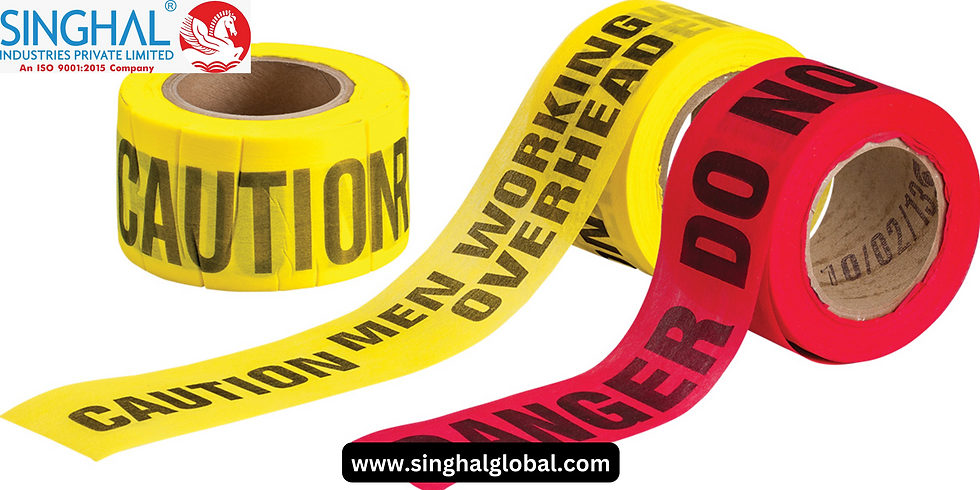The Role of Underground Warning Tape in Protecting Utilities and Infrastructure
- Digital Mkt
- Sep 18, 2024
- 5 min read
In the modern world, the infrastructure that supports our daily lives relies heavily on underground utilities, including water, gas, electricity, and telecommunications. These essential services often exist beneath our feet, making their protection critical to avoid accidents, service disruptions, and costly repairs. One effective and simple tool for safeguarding these underground utilities is warning tape. This article explores the role of underground warning tape in protecting utilities and infrastructure, including its types, applications, and benefits, as well as insights into manufacturers like Singhal Industries.

Understanding Underground Warning Tape
Underground warning tape is a highly visible plastic tape that is typically buried a few inches below the surface of the ground. It serves as a warning to excavators and utility workers about the presence of buried utilities, helping to prevent accidental damage during excavation or construction activities. The tape comes in various colors, each representing different types of utilities, such as water, gas, electricity, and telecommunications.
Importance of Warning Tape
The primary purpose of warning tape is to mark the location of underground utilities, providing a clear indication of their presence and helping to prevent potentially hazardous incidents. When excavation or construction work is planned, it’s crucial to identify and avoid these buried lines to protect both the workforce and the infrastructure itself.
Types of Underground Warning Tape
1. Excavation Warning Tape
Excavation Warning Tape is specifically designed to alert workers to the presence of underground utilities during excavation activities. It is usually bright in color, often yellow or orange, and is printed with clear warnings. This tape is used in areas where excavation is planned, serving as a precautionary measure to remind workers to take extra care.
2. Warning Tape for Underground Cable
This type of Warning Tape For Underground Cable is commonly used to indicate the presence of underground electrical cables. Typically colored red or blue, this tape is crucial in preventing accidental cuts or damages to electrical lines during digging. Utility workers rely on this tape to ensure they dig safely and avoid costly outages.
3. Utility-Specific Warning Tape
Different colors and messages on warning tape correspond to various utilities. For instance, green tape often signifies sewer lines, while purple may indicate reclaimed water lines. By using utility-specific tapes, workers can quickly identify the type of utility present, allowing for safer excavation practices.
Benefits of Using Underground Warning Tape
1. Prevention of Accidental Damage
The primary benefit of underground warning tape is its ability to prevent accidental damage to utilities during excavation. When workers are aware of the location of buried utilities, they can take the necessary precautions to avoid hitting them, reducing the risk of costly repairs and service disruptions.
2. Enhanced Safety for Workers
By marking the presence of utilities, warning tape contributes to a safer working environment. Workers are more likely to follow safety protocols when they see clear indications of underground hazards. This can lead to fewer accidents and injuries on construction sites.
3. Cost-Effectiveness
Using warning tape is a cost-effective way to enhance utility protection. The tape is relatively inexpensive compared to the potential costs associated with damaging utilities, such as repair costs, service downtime, and safety fines.
4. Ease of Installation
Underground warning tape is easy to install. It can be laid down during the installation of utilities or retrofitted into existing infrastructure. Its lightweight and flexible nature make it suitable for various applications.
5. Long-Lasting Durability
Manufactured from durable materials, underground warning tape can withstand various environmental conditions, including soil acidity, moisture, and temperature fluctuations. This durability ensures that the tape remains effective over time, providing ongoing protection for buried utilities.
The Role of Underground Warning Tape Manufacturers
Manufacturers like Singhal Industries play a vital role in providing high-quality underground warning tape. These companies focus on producing tapes that meet industry standards, ensuring that they are reliable and effective in protecting utilities. When selecting a manufacturer, it’s essential to consider factors such as product quality, variety of tape options, and adherence to safety regulations.
Quality Standards
Reputable manufacturers adhere to strict quality control measures to ensure their warning tapes are durable, visible, and capable of withstanding harsh conditions. This commitment to quality helps ensure that the tapes perform effectively in the field.
Customization Options
Many manufacturers offer customization options, allowing clients to create warning tape that meets specific project requirements. This can include custom colors, printed messages, and sizes, ensuring that the tape meets the unique needs of a project or organization.
Availability of Different Products
In addition to warning tape, manufacturers like Singhal Industries often provide a range of related products, such as utility marking flags, signs, and other safety equipment. This comprehensive offering can simplify procurement for construction and utility companies.
Conclusion
Underground warning tape plays a crucial role in protecting utilities and infrastructure from accidental damage during excavation and construction activities. By providing clear visual warnings, this simple yet effective tool enhances worker safety, prevents costly repairs, and ensures the continued functionality of essential services. With reputable Underground Warning Tape Manufacturers like Singhal Industries offering a range of high-quality warning tape options, stakeholders can confidently implement this vital safety measure in their projects. As we continue to develop and maintain our infrastructure, the importance of underground warning tape will only grow, making it an indispensable part of safe construction practices.
Frequently Asked Questions (FAQ)
1. What is underground warning tape?
Underground warning tape is a colored plastic tape buried below the surface to indicate the presence of buried utilities and prevent accidental damage during excavation.
2. What colors are used for warning tape?
Different colors represent various utilities. For example, yellow typically indicates gas lines, red signifies electrical lines, blue is used for potable water, and green is for sewer lines.
3. How deep should underground warning tape be buried?
Typically, underground warning tape should be buried 6 to 12 inches below the surface, depending on local regulations and utility requirements.
4. How durable is underground warning tape?
High-quality underground warning tape is designed to withstand harsh environmental conditions, including soil acidity and moisture, ensuring long-lasting effectiveness.
5. Is warning tape cost-effective?
Yes, using warning tape is a cost-effective measure compared to the potential costs associated with damaging underground utilities, including repair costs and service outages.
6. Who are reliable underground warning tape manufacturers?
Singhal Industries is a well-known manufacturer that provides high-quality underground warning tape and related products. Always choose manufacturers that adhere to industry standards and offer customization options.
7. Can underground warning tape be used in any type of soil?
Yes, underground warning tape can be used in various soil types. However, installation depth and conditions should be considered to ensure visibility and effectiveness.
8. What should I do if I damage a utility line?
If a utility line is damaged, immediately contact the utility company for assistance. Mark the location and cease all digging activities to prevent further issues.



Comments